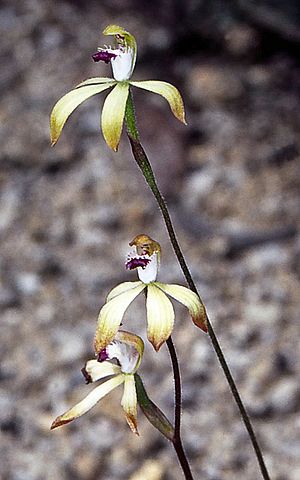Golden caps facts for kids
Quick facts for kids Golden caps |
|
|---|---|
 |
|
| Caladenia hildae growing in the Monaro | |
| Scientific classification | |
| Genus: |
Caladenia
|
| Species: |
hildae
|
| Synonyms | |
|
|
Caladenia hildae, often called golden caps, honey caladenia, or honey hood, is a beautiful type of orchid found only in the southeastern part of mainland Australia. It's a special kind of ground orchid. It grows a single leaf and produces up to four lovely yellowish-brown to golden-brown flowers. These flowers have darker tips on their sepals and petals.
Contents
What Do Golden Caps Look Like?
Golden caps are perennial plants, meaning they live for more than two years. They are also deciduous, losing their leaves at certain times. These plants grow from an underground part called a tuber, which stores food.
They have one long, thin leaf, about 70 to 200 millimeters (3 to 8 inches) long and 1 to 3 millimeters (0.04 to 0.1 inches) wide. This leaf has a few hairs on it.
Each plant can have up to four flowers on a stem that stands 80 to 200 millimeters (3 to 8 inches) tall. The flowers are usually yellowish-brown to golden-brown. Their tips are often darker.
The sepals and petals of the flower have pointed tips that hang down. The top sepal, called the dorsal sepal, stands upright. It is about 9 to 11 millimeters (0.35 to 0.43 inches) long. This sepal curves forward, forming a hood over the flower's central part, called the column. The other sepals and the petals are about 11 to 14 millimeters (0.43 to 0.55 inches) long.
The most interesting part is the labellum, which is a special lip-shaped petal. It is egg-shaped, about 6 to 9 millimeters (0.24 to 0.35 inches) long. The sides of the labellum turn upwards, and its tip is rolled under. This labellum is white with a dark purple, bumpy tip. It also has narrow white or yellow-tipped teeth along its sides. Four rows of small bumps, called calli, run along the middle of the labellum. Golden caps usually bloom in October and November.
How Golden Caps Got Their Name
The scientific name Caladenia hildae was first officially described in 1928. Two botanists, Edward Pescott and William Nicholls, wrote about it in a science magazine called The Victorian Naturalist.
The second part of the name, hildae, was chosen to honor Hilda Elliott. She helped the botanists get money to study plants. Even though some places like the Royal Botanic Gardens, Melbourne recognize C. hildae as a unique name, others consider it a type of another orchid, Caladenia testacea.
Where Do Golden Caps Grow?
Golden caps grow in specific places in southeastern Australia. You can find them in forests and woodlands that are not too dense. They prefer areas at high altitudes.
In New South Wales, they grow south of the Kybean Range. In Victoria, they are mostly found east of a town called Omeo.
Protecting Golden Caps
The Victorian Government's Department of Sustainability and Environment has listed Caladenia hildae as "rare." This means there are not many of these orchids left in the wild. It is important to protect them so they can continue to grow and thrive in their natural homes.

